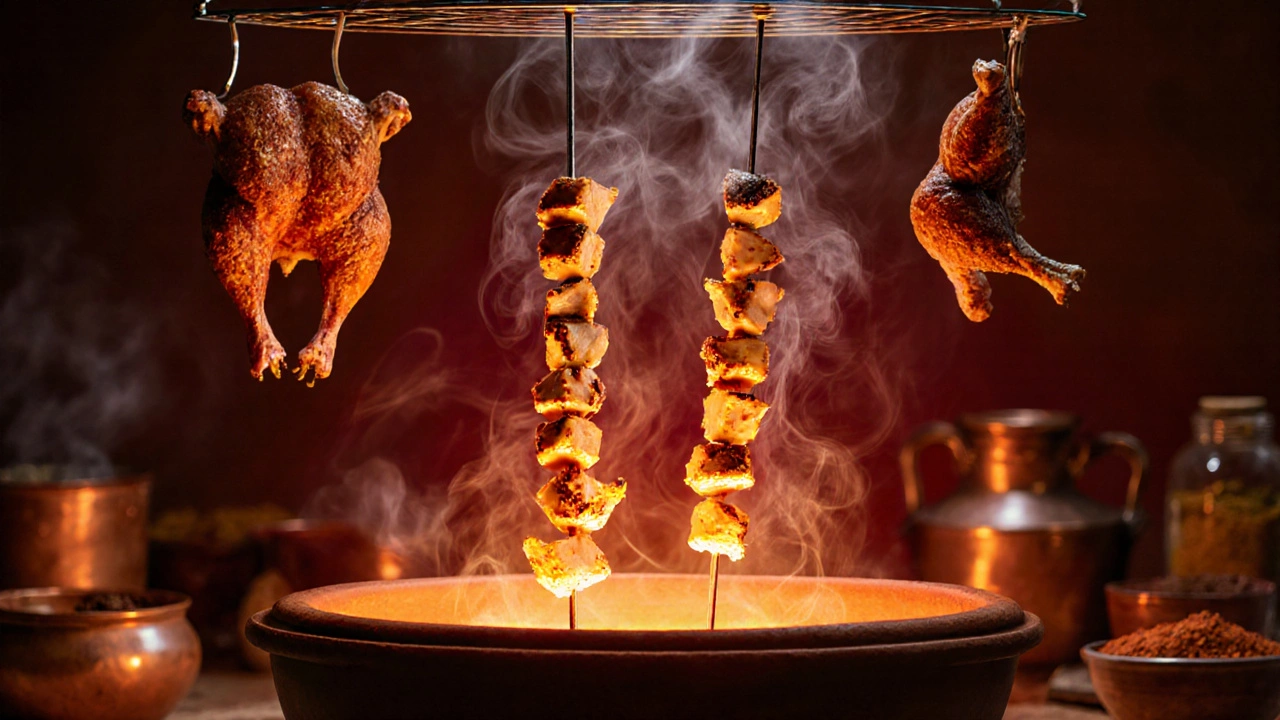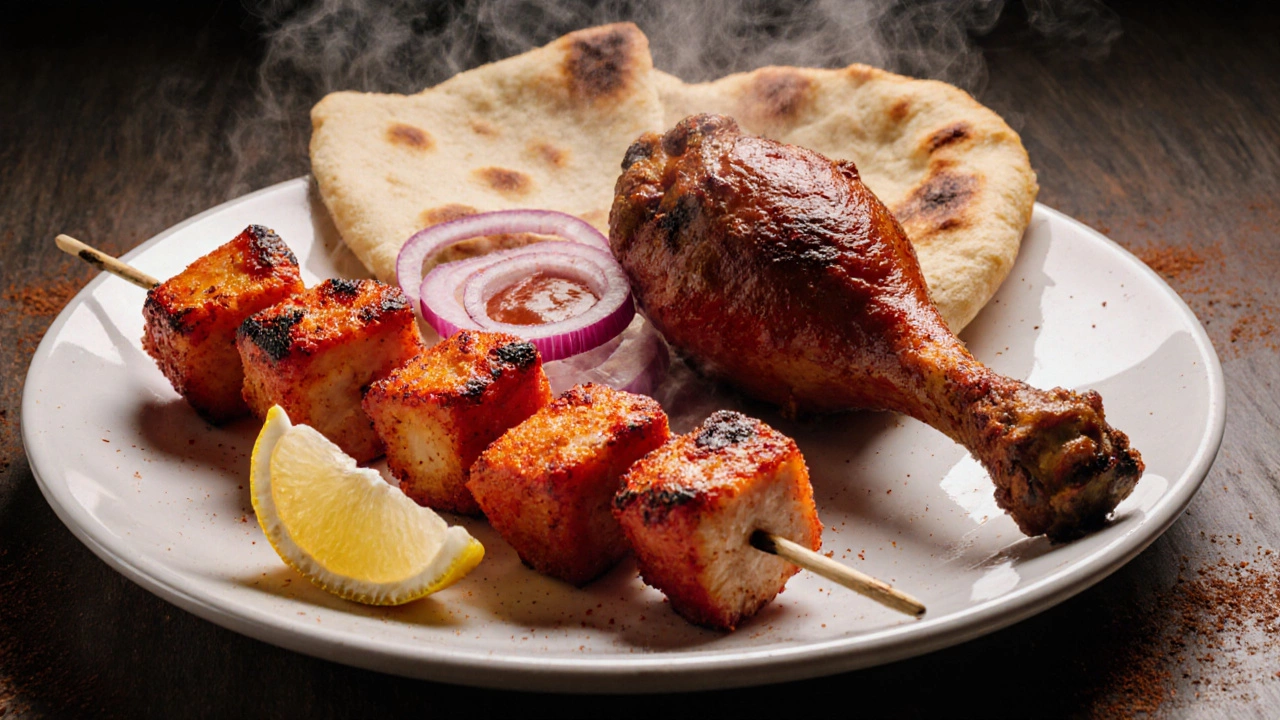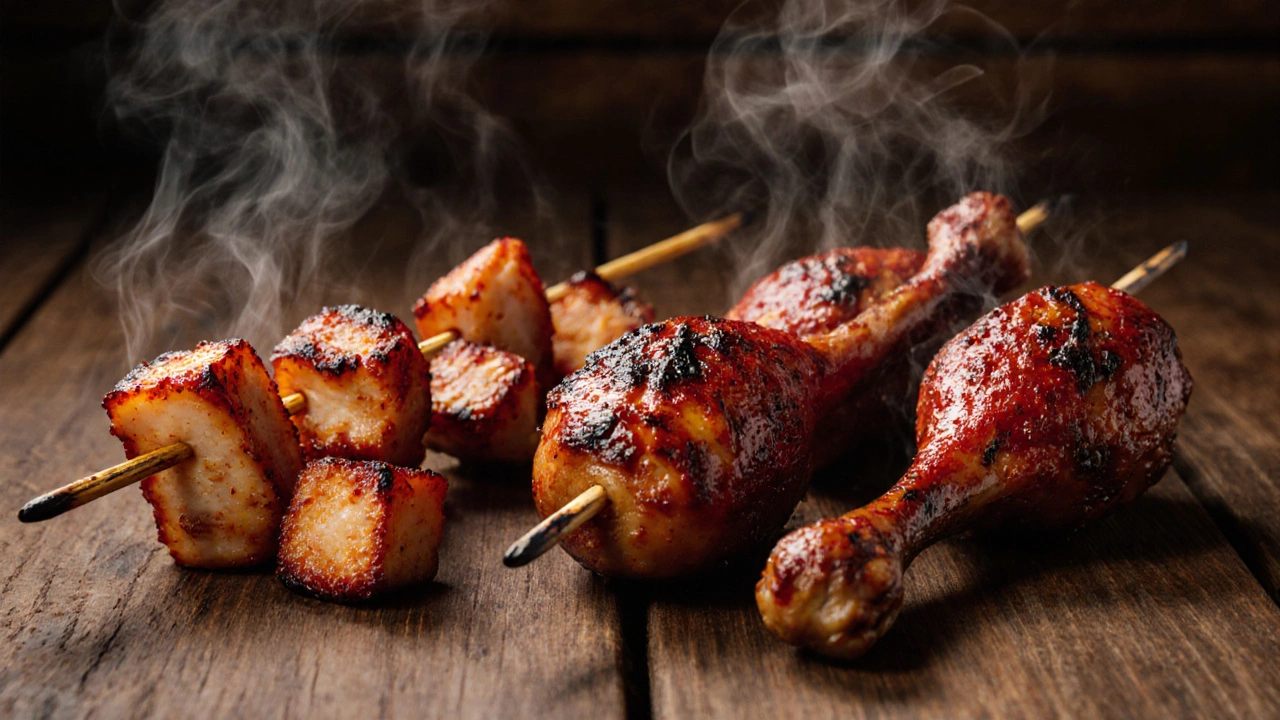Tandoori vs Tikka Chicken Selector
Choose Your Preferences
Your Perfect Match
Ever ordered chicken tikka and tandoori chicken at an Indian restaurant and wondered why they look so similar but taste different? You’re not alone. Even in Birmingham, where Indian food is as common as fish and chips, most people mix them up. They’re both marinated in yogurt and spices, grilled in a tandoor, and served with mint chutney. But the differences? They matter.
It Starts with the Cut
Chicken tikka and tandoori chicken aren’t just different sauces on the same meat. They’re built from different cuts. Chicken tikka uses boneless pieces-usually breast or thigh, cut into 1-inch cubes. That’s why it’s perfect for skewers and easy to eat with your fingers. Tandoori chicken, on the other hand, is usually made with whole chicken pieces: drumsticks, thighs, even halves. The bone stays in. That’s not just tradition-it affects flavor and texture. The bone adds richness as it cooks, and the meat stays juicier.The Marinade Isn’t the Same
Both dishes use yogurt as a base. That’s the secret to tenderizing the chicken. But after that, they split paths. Chicken tikka marinade leans into warmth and sweetness. You’ll find garam masala, ground cumin, coriander, a touch of turmeric, and often a splash of cream or kasuri methi (dried fenugreek leaves). Some versions even include a little honey or sugar to balance the heat. The result? A deep orange-red color with a rounded, aromatic flavor. Tandoori chicken? It’s bolder. The marinade is built around paprika or Kashmiri red chili powder for that signature red hue-not just for looks, but for smoky heat. Garlic, ginger, lemon juice, and a lot more cumin and coriander. The spice blend is sharper, more acidic. No cream. No sugar. Just pure, fiery, tangy flavor. That’s why tandoori chicken hits your tongue harder.The Color Comes from Different Sources
You’ve probably seen both dishes served with that bright red-orange glow. But here’s the truth: chicken tikka’s color often comes from food coloring. Yes, seriously. In many restaurants, especially outside India, red food dye is added to make it look more appetizing. The natural color from Kashmiri chilies is more of a deep crimson, not neon. Tandoori chicken, by contrast, gets its color from real spices. Kashmiri chili powder is mild but intensely pigmented. It’s the same chili used in Indian wedding feasts because it stains everything red without overwhelming heat.
How They’re Cooked Matters
Both are cooked in a tandoor-a clay oven that hits 900°F. But the way they’re placed inside changes the outcome. Chicken tikka is threaded onto metal skewers and hung vertically in the tandoor. The heat circulates around the small pieces, charring them quickly. You get crisp edges and a juicy center. Tandoori chicken is often placed on a rack or hung by the bone end, so the skin crisps while the meat slowly absorbs the smoke. The bone helps conduct heat deeper, so the meat stays moist even after 20-25 minutes of grilling.How They’re Served
Chicken tikka is almost always served as an appetizer. Think small skewers, maybe with onion rings and lemon wedges. It’s finger food. Tandoori chicken? That’s a main course. You’ll get a whole drumstick or half-chicken on a plate, often with a side of naan, salad, and mint-coriander chutney. In home kitchens, tandoori chicken is sometimes sliced and served over rice. Tikka? Rarely.Why the Confusion Exists
The mix-up started in the UK. In the 1970s, British Indian restaurants began serving chicken tikka as a standalone dish. But because the spice mix was similar to tandoori chicken, and both were red and grilled, people started calling everything “tandoori.” Over time, “chicken tikka masala”-a British invention with a creamy tomato sauce-became the most popular Indian dish in the UK. That cemented the confusion. Even now, many restaurants list “tandoori chicken” on the menu but serve what’s actually chicken tikka.
Can You Substitute One for the Other?
Technically, yes. If you’re cooking at home and only have boneless chicken, you can make a tandoori-style marinade and grill it as cubes. But you’ll lose the depth that comes from cooking with the bone. If you’re using a whole chicken and marinate it with tikka spices, you’ll get something milder, sweeter, and less smoky than true tandoori chicken. The real trick? If you want authentic tandoori chicken, use bone-in pieces and go heavy on the Kashmiri chili powder and lemon juice. For chicken tikka, go boneless, add a pinch of sugar and dried fenugreek, and don’t be afraid of that red dye if you’re going for the classic restaurant look.Try This at Home
For chicken tikka: Mix 500g boneless chicken cubes with 1/2 cup yogurt, 1 tbsp ginger-garlic paste, 1 tsp garam masala, 1 tsp ground cumin, 1/2 tsp turmeric, 1 tsp kasuri methi, 1 tsp sugar, and a splash of cream. Marinate 4 hours, then grill or broil until charred. For tandoori chicken: Use 1 whole chicken, cut into 6 pieces. Mix 1 cup yogurt, 2 tbsp Kashmiri chili powder, 1 tbsp ground cumin, 1 tbsp coriander, 1 tbsp lemon juice, 1 tbsp garlic paste, 1 tsp salt. Marinate overnight. Grill on a rack over medium heat for 25 minutes, turning once.What to Look for in a Restaurant
If you’re out for dinner and want the real deal: ask if the tandoori chicken has bones. If they say no, it’s probably tikka. Check the color-true tandoori is deep red, not neon. Taste it. Tikka is sweet and rounded. Tandoori is smoky, sharp, and a little sour. If it tastes like barbecue sauce with a kick, you’re not getting tandoori chicken.Is chicken tikka the same as chicken tikka masala?
No. Chicken tikka is grilled boneless chicken in a spicy marinade. Chicken tikka masala is that same grilled chicken, but then simmered in a creamy tomato-based sauce with more spices and cream. Tikka masala is a British invention, not traditional Indian food.
Can I make tandoori chicken without a tandoor oven?
Yes. Use your oven’s broiler setting or a grill. Preheat it to its highest temperature. Place the chicken on a wire rack over a baking sheet so fat drips away. Broil for 10-12 minutes per side until charred and cooked through. The key is high heat and direct exposure-just like a tandoor.
Why is yogurt used in both recipes?
Yogurt tenderizes the meat by breaking down proteins with its lactic acid. It also helps the spices stick to the chicken and keeps it moist during high-heat cooking. In Indian cooking, yogurt is the go-to marinade for any grilled meat-it’s natural, accessible, and works better than acidic liquids like vinegar.
Which one is spicier: chicken tikka or tandoori chicken?
Tandoori chicken is usually spicier. It uses more Kashmiri chili powder and has no sugar or cream to mellow the heat. Chicken tikka has a more balanced flavor-warm, aromatic, and slightly sweet. But spice levels depend on the cook. Always ask if you’re sensitive to heat.
Can I use chicken breast for both dishes?
You can, but it’s not ideal for tandoori chicken. Breast meat dries out faster without the bone and fat. For tandoori, thighs or drumsticks are better. For chicken tikka, breast works fine since it’s cut small and cooks quickly. If you use breast for tandoori, marinate longer and watch it closely to avoid drying.
